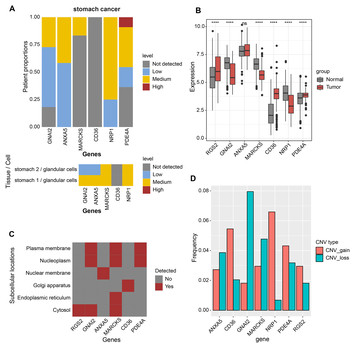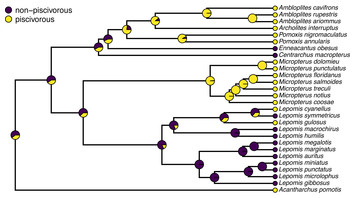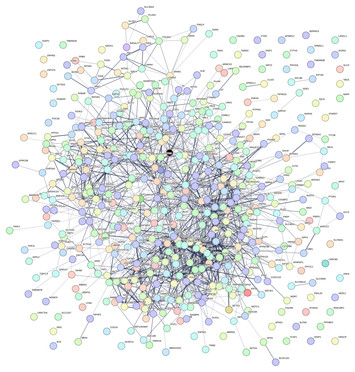PeerJ Section
Bioinformatics and Genomics
Welcome to your community’s home at PeerJ. Sections are community led and exemplify a research community’s shared values, norms and interests.
The citation average is 8.1 (view impact metrics).
55,960 Followers
Section Highlights
View all Bioinformatics and Genomics articles 

26 January 2024
Genome-wide association studies for earliness, MYMIV resistance, and other associated traits in mungbean (Vigna radiata L. Wilczek) using genotyping by sequencing approach
 Mahmood-ur- Rahman, Handling Editor
Mahmood-ur- Rahman, Handling Editor

22 January 2024
Single-cell data revealed CD14-type and FCGR3A-type macrophages and relevant prognostic factors for predicting immunotherapy and prognosis in stomach adenocarcinoma
"This article is important because it addresses the significant challenge of tumor heterogeneity in stomach adenocarcinoma (STAD) and explores the potential of single-cell sequencing technology to identify characteristic cell types. The identification of critical cell types and relevant gene modules in tumor progression provides valuable insights into the molecular mechanisms underlying STAD. Additionally, the construction of a prognostic scoring system and the development of a nomogram based on RiskScore and clinical factors offer a predictive tool for patient survival.
The article's findings have implications for the field of cancer research and clinical practice. By uncovering a single-cell atlas for STAD patients, this study contributes to our understanding of the cellular landscape of this highly heterogeneous tumor. The identification of prognostic factors and their association with patient outcomes allows for more tailored treatment strategies and improved patient care.
Furthermore, the positive feedback to immunotherapy observed in patients with low RiskScore suggests that the identified macrophage gene signature has potential implications for immunotherapeutic approaches in STAD. This finding may have a significant impact on the development of targeted therapies and personalized treatment options for STAD patients.
Overall, this article makes important contributions to the field by advancing our understanding of the molecular mechanisms underlying STAD and providing potential prognostic markers and therapeutic targets. It has the potential to shape future research directions and improve clinical outcomes for STAD patients."
 Fanglin Guan, Handling Editor
Fanglin Guan, Handling Editor
 Fanglin Guan, Handling Editor
Fanglin Guan, Handling Editor

5 January 2024
phytools 2.0: an updated R ecosystem for phylogenetic comparative methods (and other things)
"Although technically about a piece of describing software, this paper doesn't just go the extra mile beyond "normal" software papers, but instead finds a sweet spot between very thorough documentation for users, showcasing sophisticated data science, and illustrating avenues for new discovery. It will go a long way towards both enabling and encouraging comparative phylogeneticists to do and discover great things."
 Hilmar Lapp, Handling Editor
Hilmar Lapp, Handling Editor
 Hilmar Lapp, Handling Editor
Hilmar Lapp, Handling Editor

18 December 2023
Differentially expressed genes in orbital adipose/connective tissue of thyroid-associated orbitopathy
"This article sheds light on the differentially expressed genes in Thyroid-associated orbitopathy (TAO)"
 Ziarih Hawi, Handling Editor
Ziarih Hawi, Handling Editor
 Ziarih Hawi, Handling Editor
Ziarih Hawi, Handling Editor

13 December 2023
CXCL10-based gene cluster model serves as a potential diagnostic biomarker for premature ovarian failure
"This study explores the diagnostic potential of Cxcl10 in Premature Ovarian Failure (POF). By employing advanced statistical and machine learning methods, such as ROC curve analysis and LASSO regression, the study provides a comprehensive evaluation of Cxcl10's diagnostic efficacy. The findings could significantly enhance the current diagnostic tools for POF, leading to earlier detection and intervention."
 Peixin Dong, Handling Editor
Peixin Dong, Handling Editor
 Peixin Dong, Handling Editor
Peixin Dong, Handling Editor

11 December 2023
Identifying CD1c as a potential biomarker by the comprehensive exploration of tumor mutational burden and immune infiltration in diffuse large B cell lymphoma
 Nitin Amdare, Handling Editor
Nitin Amdare, Handling Editor

11 December 2023
A deep learning method for drug-target affinity prediction based on sequence interaction information mining
"A new method utilizing the cutting edge deep network paradigm but utilizing understandable and easily sourced data transformation for drug target affinity prediction. Possibly useful methodology for doing so on a large scale."
 Joseph Gillespie, Handling Editor
Joseph Gillespie, Handling Editor
 Joseph Gillespie, Handling Editor
Joseph Gillespie, Handling Editor

6 December 2023
Pharmacoscreening, molecular dynamics, and quantum mechanics of inermin from Panax ginseng: a crucial molecule inhibiting exosomal protein target associated with coronary artery disease progression
"This study elucidates the pivotal role of exosomes from epicardial adipose tissue in the progression of Coronary Artery Disease (CAD) by identifying SMAD2 as a potential protein target, linked with critical pathways like PI3K-Akt signaling. It leverages a systems biological approach, combining differential gene expression, protein network construction, and functional enrichment, and performs in-depth computational analysis, including ADME screening and molecular dynamics simulations, to assess the inhibitory potential of Panax ginseng-derived compounds on SMAD2. Inermin, a phytochemical, demonstrated significant affinity and stability with SMAD2, suggesting its potential efficacy in managing CAD. This multifaceted approach not only enhances our understanding of the role of exosomes and associated proteins in CAD but also sets a precedent for utilizing innovative methodologies and natural compounds in drug discovery, potentially leading to the development of novel therapeutic strategies and drugs. The findings can have far-reaching implications in providing more effective and targeted interventions for CAD and other cardiovascular diseases, contributing to advancements in cardiovascular research, pharmaceutical research, and clinical practices."
 Mahesh Gokara, Handling Editor
Mahesh Gokara, Handling Editor
 Mahesh Gokara, Handling Editor
Mahesh Gokara, Handling Editor

5 December 2023
Dark kinase annotation, mining, and visualization using the Protein Kinase Ontology
"This paper will be very useful for all those researchers working on kinases."
 Aristóteles Góes-Neto, Handling Editor
Aristóteles Góes-Neto, Handling Editor
 Aristóteles Góes-Neto, Handling Editor
Aristóteles Góes-Neto, Handling Editor

5 December 2023
miR-4270 suppresses hepatocellular carcinoma progression by inhibiting DNMT3A-mediated methylation of HGFAC promoter
"The present study significantly contributes to the existing body of research pertaining to hepatocellular carcinoma (HCC). This study elucidates the functional significance of a particular gene, miR-4270, in its capacity as a tumor suppressor. The aforementioned discoveries not only contribute to the advancement of our understanding about the molecular mechanisms behind HCC, but also propose that miR-4270 has promise as a possible therapeutic target for HCC treatment. The aforementioned progress has significant significance within the discipline, perhaps establishing a foundation for more efficacious methodologies in the management of this particular kind of cancer."
 Peixin Dong, Handling Editor
Peixin Dong, Handling Editor
 Peixin Dong, Handling Editor
Peixin Dong, Handling Editor
55,960 Followers







